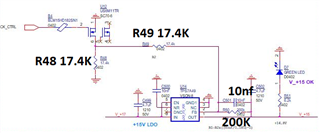Tool/software:
hello,
We are using the TPS7A49 in the below circuit.

When OUT=8V, we short R48, connected to R49 and the FB pin, so TPS7A49 OUT changes from 8V to 15V (R48 shorted via transistor for OUT=15V and connected for OUT=8V).
We perform this when the output is stable at 8V.
The change to 15V takes few msec.
Is a delay of few msec in OUT change normal?
I tried removing the NR/SS capacitor (thought the SS cap will affect the change), LDO output cap and the load’s power supply cap, but the effect was minimal.
It still takes around 1msec.
I calculated the average ΔI for this change to be 1mA (ΔI=C*ΔV/ΔT).
The LDO can easily driver higher currents than that.
Why is the loop so slow?
How can we make it faster?
thanks
Gil

